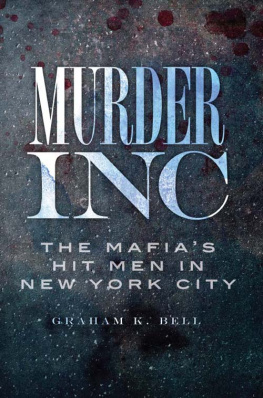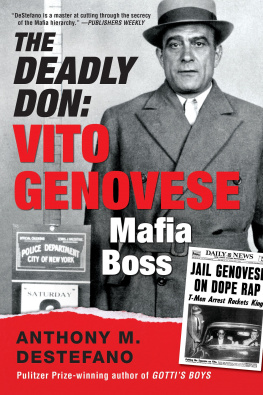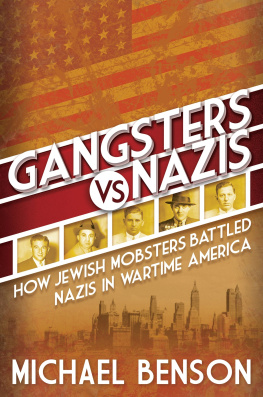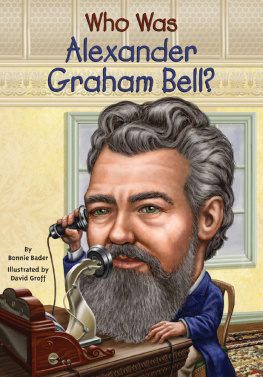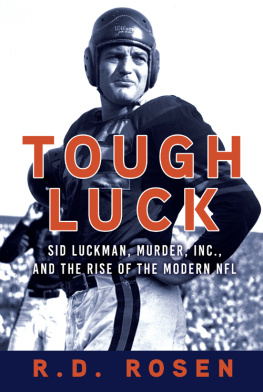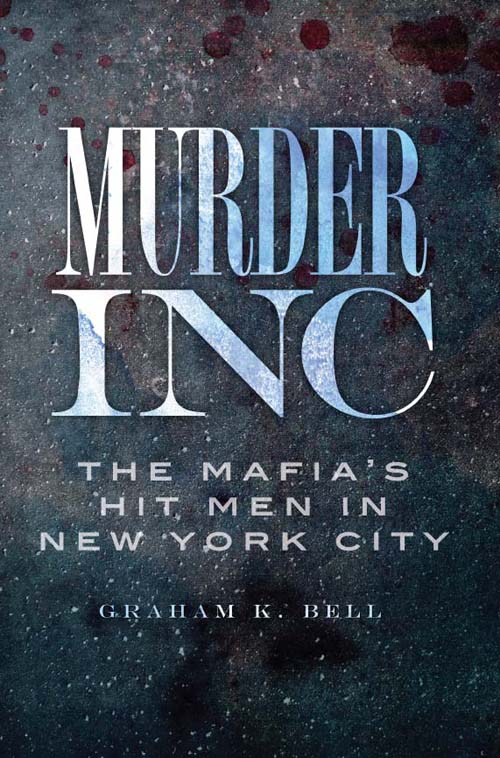MURDER
INC
MURDER
INC
THE MAFIAS
HIT MEN IN
NEW YORK CITY
GRAHAM K.BELL

Published by The History Press
Charleston, SC 29403
www.historypress.net
Copyright 2010 by Graham K. Bell
All rights reserved
Cover images courtesy of the Library of Congress.
First published 2010
e-book edition 2011
ISBN 978.1.61423.149.3
Bell, Graham.
Murder, Inc. : the Mafia's hit men in New York City / Graham Bell.
p. cm.
print edition ISBN 978-1-60949-135-2
1. Mafia--New York (State)--New York--History--20th century. 2. Mafiosi--New York (State)--New York--History--20th century. 3. Assassins--New York (State)--New York-- History--20th century. 4. Organized crime--New York (State)--New York--History--20th century. I. Title.
HV6452.N72M34185 2010
364.152309227471--dc22
2010042769
Notice: The information in this book is true and complete to the best of our knowledge. It is offered without guarantee on the part of the author or The History Press. The author and The History Press disclaim all liability in connection with the use of this book.
All rights reserved. No part of this book may be reproduced or transmitted in any form whatsoever without prior written permission from the publisher except in the case of brief quotations embodied in critical articles and reviews.
C ONTENTS
I NTRODUCTION
The body of one of the most efficient murderers in history, and certainly the best criminal informant in the life of the American republic, lay prone on one of the ledges of the Half Moon Hotel, on Coney Island, New York. It was November 12, 1941, and the corpse in question was that of Abraham Kid Twist Reles.
Before he died, Reles had created headlines throughout America concerning the existence of a strange, lethal organization called Murder, Incorporated (or Murder, Inc.). This was, literally, the hit squad of the vast criminal organization that later generations, sated with the film The Godfather, would call the Mafia. Before he died, Reles had admitted to more than twenty murders; thanks to his testimony, seven men took the long and fatal journey to the electric chair in Sing Sing prison. One of these men, Lepke Buchalter, is so far the only top-echelon boss of the Mafia ever to be executed. Another of this number, Harry Straussalso known as Pittsburgh Phil, Big Harry and Pepis perhaps the most able hit man the Mafia ever produced, having taken out, by the most conservative estimates, more than one hundred men.
When Reles's body was discovered on the ledge of the Half Moon Hotel, a legend was createdof Murder, Inc. and of Reles, the canary who could sing but could not fly.
Chapter 1
G ENESIS IN S ICILY ,
E XODUS TO A MERICA
The story of Murder, Inc., as well as the death of Reles, starts many thousands of miles away from the bustle of New York, and hundreds of years before the war year of 1941, on the Mediterranean island of Sicily.
Conquered by the Romans in the centuries before the coming of the Caesars under Augustus, the island was seen by its mainland masters as a gigantic breadbasket whose sole role was to provide bread for the teeming multitude of the metropolis of Rome. By the coming of Augustus, local rule on the island had been savagely crushed, rebellions had been led by slaves and city-states such as Syracuse had been brutally oppressedthe losers, if they were lucky, were sent as slaves to the various mines in Sicily or, if they were not, were sent to the Coliseum in Rome, where their deaths were watched with sadistic fascination by the Roman mob; sometimes they were made to taste the agonies of crucifixion, a punishment known for centuries before the body of Christ was hung in Jerusalem.
The Sicilians ever afterward hated and feared any government put over them as being one of exploiters from foreign lands, whose main intention was to wring as much wealth out of the island as possible. They were usually right. Over the next few centuries, the island went through a bewildering change of rulers: Greeks from Byzantium, Vandals from North Africa, Ostrogoths, Arabs and Normansall came to the land to exploit but rarely to build. Even the savage war criminal Richard I, the king of England, the Lionheart, landed on the island on his murderous way to the third crusade and, to the surprise of no one who knew him, created havoc.
Sicily was booted backward and forward by the great powers of Europe, one country never staying for too long as the imperial power. The result was that, unlike in the rest of Europe, there was no settled period of law and governance on this island. The results of these facts were obvious: the landlords, the natural leaders of the community, began to expand their powers in ways that the kings and parliaments of the rest of the continent (in the northwest, anyway) had managed to curtail. The beleaguered peasants of the island, progressively tyrannized, began to form local self-help organizations, which were later given the generic title of the Mafia, a name whose meaning has been discussed for centuries. These groups attacked the landowners estates and servants, warning them of the folly of their ways.
What happened next was the classic lesson to anyone wishing to understand the rudiments of divide and rule: the landowners quietly suggested to the local bands of Mafiosi that it would be more advisable to join together and mutually terrorize and plunder the peasants and townsmen.
With the enlightened self-interest that has always been one of the attributes of able men, the local gangs accepted these conditions with alacrity, and the Sicilians soon found themselves plundered not only by their landlords but also by their own erstwhile protectors.
The reunification of Italy in the mid-nineteenth century, so lusted after by the romantics in so many nations, had very little effect in Sicily, where the terrorization of the population continued apace.
The huge emigration from Sicily and Italy to the United States in the nineteenth and early twentieth centuries (the more ambitious members of the population, like millions from the rest of Europe) not only presented the New World with thousands of industrious workersmen and women who would enrich their new homeland with their cultures and industrybut also allowed the criminal gangs of Sicily to follow their compatriots to the New World and, as in the old one, exploit them mercilessly.
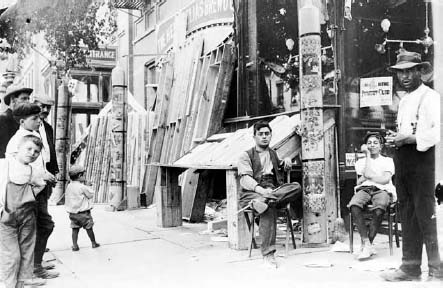
Little Italy during the height of Italian immigration. Courtesy of the George Grantham Bain Collection, Library of Congress.
It must be pointed out here and now that this book is a volume, for the most part, about treachery, murder and greed, and many of the main characters will be of Italian or Sicilian stock. It must be noted, however, notwithstanding films like The Godfather or Goodfellas, that the overwhelming number of these much maligned people were and are absolutely respectable, hardworking and honest. Their culture has enriched their country to an unimaginable degree. Their labor has cleared the forests; built the canals, railways and highways; and constructed the schools that have enabled the people of the Italian peninsula to pull themselves up by their bootstraps and produce American worthies such as Francis Ford Coppola, Robert De Niro, Rudolph Giuliani and Rocky Marciano to name but a few. (In case anybody thinks that these people were nothing but ignorant layabouts, it should be pointed out that along with the Irish Americans, the Italian Americans produced from their ranks most of the men and women who fought for their countries in both world wars and Korea and who followed the trumpet in a way few other ethnicities did in the war in Vietnam. The author would like to take this opportunity to state his admiration regarding the patriotism, industry and progressivism of the people of Italian-Sicilian stock.)

